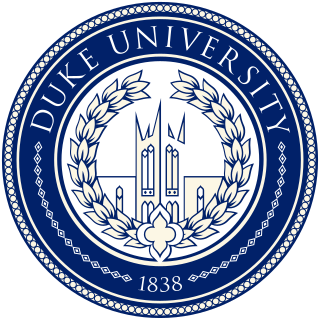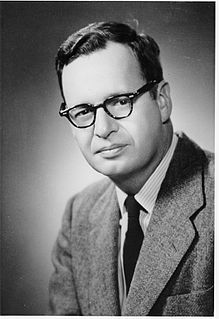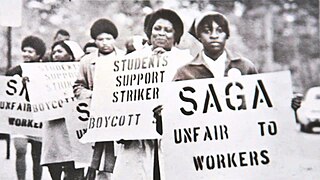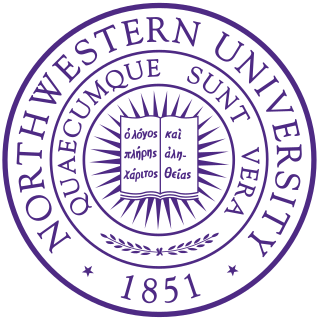
Duke University is a private research university in Durham, North Carolina. Founded by Methodists and Quakers in the present-day town of Trinity in 1838, the school moved to Durham in 1892. In 1924, tobacco and electric power industrialist James Buchanan Duke established The Duke Endowment and the institution changed its name to honor his deceased father, Washington Duke.

The University of the District of Columbia (UDC) is a public historically black land-grant university in Washington, D.C. It was established in 1851 and is the only public university in the city. UDC is a member school of the Thurgood Marshall College Fund. The full university system offers workforce and certificate programs in addition to Associate, Baccalaureate, Master's, professional, and Doctoral degrees. The university's academic schools and programs include the UDC Community College, College of Arts and Sciences, School of Engineering and Applied Sciences, School of Business and Public Administration, Colleges of Agriculture, Urban Sustainability & Environmental Sciences, and David A. Clarke School of Law.

Douglas Maitland Knight was an American educator, businessman, and author. He was a former professor of literature at Yale University prior to his presidency at Lawrence College from 1954 to 1963. Stemming from his work at Lawrence College was his subsequent term as president of Duke University, where he served until he resigned in 1969 following student protests and the takeover of the university's main administrative building by students calling for a black cultural center and African-American studies program, among other things. Controversy over these issues led to his transition into the business world at RCA and Questar Corporation. Knight never fully retired, and was known to consult for Questar's Board of Trustees years after his departure.

The Confederate Monument, University of North Carolina, commonly known as Silent Sam, is a bronze statue of a Confederate soldier by Canadian sculptor John A. Wilson, which once stood on McCorkle Place of the University of North Carolina at Chapel Hill (UNC) from 1913 until it was pulled down by protestors on August 20, 2018. Its former location has been described as "the front door" of the university and "a position of honor".
In 1968, a series of protests at Columbia University in New York City were one among the various student demonstrations that occurred around the globe in that year. The Columbia protests erupted over the spring of that year after students discovered links between the university and the institutional apparatus supporting the United States' involvement in the Vietnam War, as well as their concern over an allegedly segregated gymnasium to be constructed in the nearby Morningside Park. The protests resulted in the student occupation of many university buildings and the eventual violent removal of protesters by the New York City Police Department.

The protests of 1968 comprised a worldwide escalation of social conflicts, predominantly characterized by popular rebellions against state militaries and the bureaucracies.
The History of Duke University began when Brown's Schoolhouse, a private subscription school in Randolph County, North Carolina, was founded in 1838. The school was renamed to Union Institute Academy in 1841, Normal College in 1851, and to Trinity College in 1859. Finally moving to Durham in 1892, the school grew rapidly, primarily due to the generosity of Washington Duke and Julian S. Carr, powerful and respected Methodists who had grown wealthy through the tobacco industry. In 1924, Washington Duke's son, James B. Duke, established The Duke Endowment, a $40 million trust fund, some of which was to go to Trinity College. The president thus renamed the school Duke University, as a memorial to Washington Duke and his family.
The Black Student Movement (BSM) is an organization at the University of North Carolina at Chapel Hill. It is the second largest student-run organization and one of the largest cultural organizations on the school's campus. The organization was created on November 7, 1967 to combat problems of black recruit, admissions, and integration on UNC-CH campus. Black Student Movement has created many subgroups and committees such as: Opeyo! Dance Company, Celebration of Black Womanhood (CBW), Emphasizing Brotherhood Across Campus Effectively (EmBrACE), Harmonyx A Capella, UNC Gospel Choir, Ebony Reader's Onyx Theatre (EROT), Black Ink and the Political Action Committee (PAC) to name a few.
Malcolm X Liberation University was an experimental educational institution inspired by the Black Power and Pan-Africanist movements and located in Durham and Greensboro, North Carolina. Howard Fuller, Bertie Howard, and several other African American activists in North Carolina founded the school in response to the 1969 Allen Building Takeover on Duke University's campus. It operated from October 25, 1969 to June 28, 1973. One of the main reasons the school closed was that political conflicts damaged the school's reputation, making it more difficult to acquire funding. Due to financial setbacks, the school operated for only three years.
The Local 77 chapter of the American Federation of State, County and Municipal Employees is a Duke University labor union established in August 1965. It initially began as the Duke Employees Benevolent Society in February 1965, led by Oliver Harvey. The formation of Local 77 was directed towards improving work conditions for the working class employees, most of whom were African-American. Members fought for minimum wage increases, improvements in working conditions, and medical benefits for employees. The union members of Local 77 demanded a systematic way of dealing with workplace complaints that were impartial to the Duke University administration. Because the majority of the union's members were African-American, several of the goals overlapped with the ideas of the Civil Rights Movement.
The Duke University Hospital unionization drives of the 1970s involved two distinct organizing efforts aimed at uniting the service workers of Duke Hospital. The drives were defined by their fusion of the fight for worker’s rights with the battle for racial equality. The first drive in 1974 was characterized by unity amongst the workers involved, including members of the American Federation of State, County, and Municipal Employees Local 77, and a strong spirit of activism, but failed due to political infighting and resistance by the University. The second drive, organized by a representative of the national American Federation of State, County and Municipal Employees (AFSCME) in 1978, was formed on the ideals of inclusion and keeping the union free of politics. The 1978 drive failed as well, in part due to the management company that Duke hired to instill fear in its workers, and partly due to the overall lack of spirit for organizing. Despite the failure of these drives, they offer a revealing example of the convergence of civil rights and workers rights, highlighting both the status of the civil rights movement in Durham and the difficulty of instigating grassroots-level change in a corporation the size of Duke Hospital, not to mention larger Duke University community.
The Third World Liberation Front (TWLF) rose in 1968 as a coalition of ethnic student groups on college campuses in California in response to the Eurocentric education and lack of diversity at San Francisco State College and University of California, Berkeley. The TWLF was instrumental in creating and establishing Ethnic Studies and other identity studies as majors in their respective schools and universities across the United States.
The Student Organization for Black Unity was a group of African American students in North Carolina, United States led by Marxist thinker Nelson Johnson. Centered in Greensboro, it was formed in 1969, originally to stop the forced integration of black schools with white students so as to provide an educational environment for black students in which they would not be made to feel inferior to white people. The organization was an extension of the Black Power movement. The organization later extended its mandate, and advocated for the civil rights of all the people in the black community, at which point its name was changed to the Youth Organization for Black Unity by Roderick D. Bush.
In 1968, the Third World Liberation Front (TWLF), a coalition of the Black Students Union, the Latin American Students Organization, the Filipino American Collegiate Endeavor (PACE) the Filipino-American Students Organization, the Asian American Political Alliance, and El Renacimiento, a Mexican-American student organization, formed at San Francisco State University (SFSU) to call for campus reform. Another Third World Liberation Front formed at University of California, Berkeley in January 1969. These coalitions initiated and sustained the Third World Liberation Front strikes of 1968, one of the longest student strikes in US history.

The UNC Food Workers Strike was a labor strike at the University of North Carolina at Chapel Hill that began on February 23 and lasted until December 9, 1969. Through the leadership of Mary Smith and Elizabeth Brooks and with the support of student groups and civil rights activists, the strike was organized around a list of demands to improve the working conditions of black food workers. The protesting employees of Lenoir Hall presented this list to University Chancellor J. Carlyle Sitterson, who responded by asserting his commitment "to be[ing] responsive to the educational needs of. .. all races, colors, and creeds" but also his inability to treat any group with preference and to make significant changes on their behalf. He directed a police response to campus disruptions with North Carolina Governor Robert W. Scott, further instigating the protesters and drawing widespread attention to the issue. The subsequent formation of the UNC Non-Academic Employees Union prompted Governor Scott to negotiate with and ultimately accept the terms of the protesters on March 21, 1969. UNC facility employees experienced an increase in wage and working conditions, and this lasted until food management transferred from internal to contractual service provided by SAGA Food Service less than a month later. The change in employers sparked workers, many of whom participated in the first strike, to voice their discontent once again. Employees and students responded immediately, with the strike resuming, among other forms of protest, until its conclusion on December 9, 1969, when black supporters threatened to descend on the campus to elevate the issue if union negotiations did not begin.
Helen Gray Crotwell served as the Associate Minister to Duke University from 1973 to 1979. She had previously served as the associate director of the Duke Methodist campus ministry. During her time at Duke, she published a compilation of sermons written by women and participated as a campus minister in the Silent Vigil at Duke University. Crotwell was the first woman appointed as a district superintendent in the United Methodist Church in North Carolina and one of the first in the Southeast. She served as the chairperson of the Commission on the Status and Role of Women in the United Methodist North Carolina Conference and advocated for inclusivity and female empowerment in the church. Her major interests included women and the church, women and theology, counseling, and the church and social justice.

Similar to many undergraduate campuses across the United States, Northwestern University has had multiple student protests, some contemporary, but most are concentrated in the 1960s and early 1970s. Subjects of protests include anti-war sentiments, black student relations, and more.

Walltown is a historically African-American neighborhood in Durham, North Carolina. The neighborhood is located between West Durham Historic District and Trinity Historic District, north of Duke University East Campus. Historically, the neighborhood was a working class neighborhood for African-American employees of Duke University and local tobacco and textile mills in Durham. Walltown was named after George Wall, a former enslaved person, who was one of the first people to purchase a lot in the area. Members of the community were active in the civil rights movement and desegregation in Durham. Since the beginning of the twenty-first century, Walltown has been faced with gentrification.

The Douglas M. and Grace Knight House, also known as Knight House, is a Modernist-style mansion in Durham, North Carolina. The house, designed by Alden B. Dow, previously served as the official residence for presidents of Duke University and is now used by the university as an event space, conference facility, and guest house. On April 6, 1968, four-hundred and fifty university students marched to the house during the Silent Vigil at Duke University. The house, previously called University House, was officially named after Douglas Knight and Grace Nicholas Knight in 2003.
Columbia University in New York City, New York, has seen numerous instances of student protests, particularly beginning in the late 20th century.









